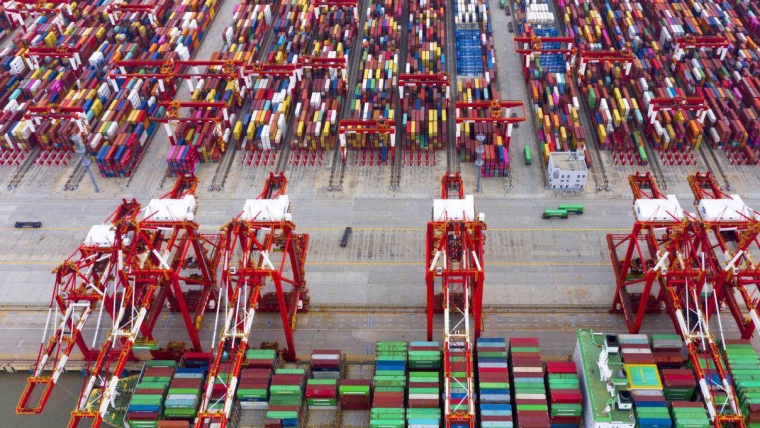
Just as China led the world in economic recovery in the aftermath of the global financial crisis of 2008, it is playing a similar role today. Its post-COVID rebound is gathering momentum amid a developed world that remains on shaky ground. Unfortunately, this is a bitter pill for many to swallow – especially in the United States, where demonisation of China has reached epic proportions.
The two crises are, of course, different. Wall Street was ground zero for the 2008 crisis, while the COVID-19 pandemic was spawned in the wet markets of Wuhan. But in both cases, China’s crisis-response strategy was far more effective than that deployed by the US. In the five years following the onset of the 2008 crisis, annual real GDP growth in China averaged 8.6% (on a purchasing power parity basis). While that was slower than the blistering (and unsustainable) 11.6% average pace of the five previous years, it was four times the US economy’s anemic 2.1% average annual growth over the post-crisis 2010-14 period.
China’s pandemic response hints at a comparable outcome in the years ahead. The GDP report for the third quarter of 2020 suggests a rapid return to the pre-COVID trend. The 4.9% year-on-year figure for real GDP growth does not convey a full sense of the self-sustaining recovery that is now emerging in China. Measuring economic growth on a sequential quarterly basis and converting those comparisons to annual rates – the preferred construct of US statisticians and policymakers – provides a much cleaner sense of real-time shifts in the underlying momentum of any economy. On that basis, China’s real GDP rose at an 11% sequential annual rate in the third quarter, following a 55% post-lockdown surge in the second quarter.
The comparison with the US is noteworthy. Both economies experienced comparable contractions during their respective lockdowns, which came one quarter later for the US. China’s 33.8% sequential (annualized) plunge in the first quarter was almost identical to the 31.2% US contraction in the second quarter. Based on incoming high-frequency (monthly) data, the so-called GDPNow estimate of the Atlanta Federal Reserve puts third-quarter sequential real GDP growth in the US at around 35%. While that is a welcome and marked turnaround from the record decline during the lockdown, it is about 20 percentage points short of China’s post-lockdown rebound and still leaves the US economy about 3% below its peak of late 2019.
Post-lockdown rebounds are not the real story, however. They are akin to the snapback of a stretched rubber band – or in statistical terms, the arithmetical result of restarting an economy that has just been subjected to an unprecedented sudden stop. The true test comes after the snapback, and that’s where China’s strategy has its greatest advantage.
China’s response to COVID-19 borrowed a page from its playbook in 2008, when it ring-fenced its financial markets from the toxic fallout of the subprime crisis. The objective back then was crystal clear from the start: address the source of the shock, itself, rather than the collateral damage the shock caused. The CN¥4 trillion ($596.4 billion) fiscal stimulus of 2008-09 worked only because China had taken strong actions to insulate its markets from a virulent financial contagion.
China’s approach today is similar: first, insulate its citizens from a virulent pathogenic contagion with draconian public-health measures aimed at containing and mitigating the spread of the disease, and then – and only then – make judicious use of monetary and fiscal policy to reinforce the post-lockdown snapback. This is very different from the approach taken in the US, where the post-lockdown debate is more about using monetary and fiscal policies as front-line instruments of economic liberation, rather than relying on disciplined public-health measures aimed at virus containment.
This underscores the sharp contrast between China’s COVID-first strategy and the America-first approach of US President Donald Trump’s administration. In China, unlike the US, there is no political and public resistance to masks, social distancing, and aggressive testing as requisite norms of the COVID-19 era. Meanwhile, the US is in the midst of its third serious wave of infection while China continues to exercise prompt and effective control over new outbreaks. Earlier this autumn, for example, some nine million citizens in Qingdao were tested in just five days after a relatively small outbreak affecting fewer than 20 residents. By contrast, Trump wears his own experience with COVID-19 infection as some perverse badge of courage, rather than as a warning of what may lie ahead.
In this context, China’s impressive GDP results in the third quarter stand in even sharper contrast with the precarious post-lockdown state of the US economy. Ongoing distress in the US labor market – unemployment insurance claims remained above 800,000 on a four-week moving average through mid-October, and the 7.9% national unemployment rate in September was still more than double its pre-pandemic 3.5% level – leaves America’s consumer-led economy highly vulnerable to a setback. The confluence of a new COVID-19 wave with the on-again, off-again political debate over another fiscal relief package has effectively neutralized the animal spirits that have long powered economic recovery in the US.
While China’s 11.2% sequential (annualized) growth in the third quarter of this year builds effectively on its post-lockdown snapback, some lingering signs of weakness are evident in several key segments of consumer services – namely travel, leisure, and entertainment. Human nature is the same everywhere, with fear and caution enduring, even in countries where aggressive containment measures are working. For those unwilling to focus on containment, like the US, the long shadow of COVID-19 speaks volumes to the ever-present perils of a double-dip recession. That is exactly what has happened in the aftermath of eight of the last 11 US recessions. The contrast with China’s self-sustaining recovery couldn’t be more striking.
Stephen S. Roach is a faculty member at Yale University and the author of Unbalanced: The Codependency of America and China. Copyright: Project Syndicate, 2020, published here with permission.
13 Comments
a great and timely article.
well done.
The focus on 'sequential [quarterly] annualised' figures serves only to confuse. The remarkable figure is the "4.9% year-on-year figure for real GDP growth" comparing third quarter 2020 with third quarter 2019. The implication for New Zealand is that China is going to become even more important as a trading partner assuming that economics rather than geopolitics is the determining factor.
KeithW
keep an eye on
tradeintelligence.mbie.govt.nz
the increasing reliance will keep showing up.
Indeed, but increasing reliance to overseas will be the hall mark of the down fall for many countries - the rest of the world just waking up to this Xing, so interesting times ahead for NZ too. The article clearly mentioned the 'self reliance of China for it's own good' as good example. OZ geopolitically playing up a bit recently, so being punish by China trading wise.. honestly? NZ try to geopol tip-toeing here. But sadly, as you've highlighted here in the past? despite 'Asians' is now constitute as the 'third largest ethnicity' in NZ by stats.. they're still being sidelined by current NZ policy makers as comparisons to Maori (second largest) & Pasifica (fourth largest) for study placement, govt jobs etc. - OZ is actually better on that regards... interesting.
When NZ gets enough ambitious Asians of whatever hue to start a political party then - as they say - the cat will definately be amongst the pigeons (or Dodo's, depending on your point of view). Surprised it hasn't happened earlier actually.
Indians are considered Asians in census
The implication for New Zealand is that China is going to become even more important as a trading partner assuming that economics rather than geopolitics is the determining factor.
The geopolitics are not favourable to small nations like NZ - it still seems a matter of are you with us or against us, as far as the US is concerned.
US Democratic presidential candidate Joe Biden believes that Russia poses the biggest threat to the United States on the international arena, he said in an interview with CBS published Sunday.
The interviewer asked the former vice president which country he thinks to be the most dangerous for the US. "Well, I think the biggest threat to America right now in terms of breaking up our security and our alliances is Russia," he said. "Secondly, I think that the biggest competitor is China." "And depending on how we handle that will determine whether we're competitors or we end up being in a more serious competition relating to force," Biden added. Link
So US has got Trump p1ssing on China's parade and Biden wants to add Russia to the rainshower? No wonder there's so many enquiries by Americans to emigrate - what a basketcase nation. Hopefully I live to see the day that the US finally gets its comeuppance - long delayed but well deserved.
Hopefully not with an incoming Sarmat in the face though.
If you take China's official statistics at face value, it does indeed look strong.
realterms
China's official economics statistics have stacked up OK for a long time. There is a big tendency for mid-level officials to try and hide stuff-ups but at higher levels they realised after the 1958-1961 fiasco that producing false figures is a bit like shooting oneself in the foot.
KeithW
They're better than they used to be, I agree. But certainly there are plenty who take them with a grain of salt, still.
https://www.economist.com/finance-and-economics/2020/10/15/can-chinas-r…
There is no reason why we should not be a neutral nation and trade with who ever we want. I think we would be far better of, rather than cowing down to out dated alliances.

We welcome your comments below. If you are not already registered, please register to comment
Remember we welcome robust, respectful and insightful debate. We don't welcome abusive or defamatory comments and will de-register those repeatedly making such comments. Our current comment policy is here.